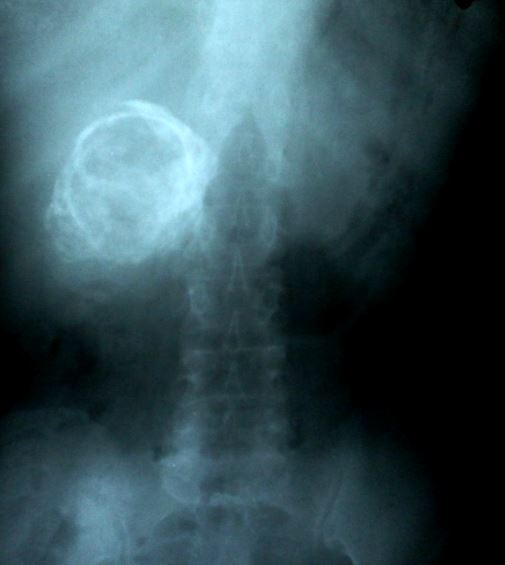[1]
Stinton LM, Shaffer EA. Epidemiology of gallbladder disease: cholelithiasis and cancer. Gut and liver. 2012 Apr:6(2):172-87. doi: 10.5009/gnl.2012.6.2.172. Epub 2012 Apr 17
[PubMed PMID: 22570746]
[2]
Andercou O, Olteanu G, Mihaileanu F, Stancu B, Dorin M. Risk factors for acute cholecystitis and for intraoperative complications. Annali italiani di chirurgia. 2017:88():318-325
[PubMed PMID: 29068324]
[3]
Wang L, Sun W, Chang Y, Yi Z. Differential proteomics analysis of bile between gangrenous cholecystitis and chronic cholecystitis. Medical hypotheses. 2018 Dec:121():131-136. doi: 10.1016/j.mehy.2018.07.004. Epub 2018 Jul 5
[PubMed PMID: 30396466]
[4]
Guarino MP, Cong P, Cicala M, Alloni R, Carotti S, Behar J. Ursodeoxycholic acid improves muscle contractility and inflammation in symptomatic gallbladders with cholesterol gallstones. Gut. 2007 Jun:56(6):815-20
[PubMed PMID: 17185355]
[5]
Benkhadoura M, Elshaikhy A, Eldruki S, Elfaedy O. Routine histopathological examination of gallbladder specimens after cholecystectomy: Is it time to change the current practice? Turkish journal of surgery. 2018 Sep 11:():1-4. doi: 10.5152/turkjsurg.2018.4126. Epub 2018 Sep 11
[PubMed PMID: 30248293]
[6]
Smith EA, Dillman JR, Elsayes KM, Menias CO, Bude RO. Cross-sectional imaging of acute and chronic gallbladder inflammatory disease. AJR. American journal of roentgenology. 2009 Jan:192(1):188-96. doi: 10.2214/AJR.07.3803. Epub
[PubMed PMID: 19098200]
Level 2 (mid-level) evidence
[7]
Yeo DM, Jung SE. Differentiation of acute cholecystitis from chronic cholecystitis: Determination of useful multidetector computed tomography findings. Medicine. 2018 Aug:97(33):e11851. doi: 10.1097/MD.0000000000011851. Epub
[PubMed PMID: 30113479]
[8]
Kaura SH,Haghighi M,Matza BW,Hajdu CH,Rosenkrantz AB, Comparison of CT and MRI findings in the differentiation of acute from chronic cholecystitis. Clinical imaging. 2013 Jul-Aug
[PubMed PMID: 23541278]
[9]
Chamarthy M, Freeman LM. Hepatobiliary scan findings in chronic cholecystitis. Clinical nuclear medicine. 2010 Apr:35(4):244-51. doi: 10.1097/RLU.0b013e3181d18ef5. Epub
[PubMed PMID: 20305411]
[10]
Guarino MP, Cocca S, Altomare A, Emerenziani S, Cicala M. Ursodeoxycholic acid therapy in gallbladder disease, a story not yet completed. World journal of gastroenterology. 2013 Aug 21:19(31):5029-34. doi: 10.3748/wjg.v19.i31.5029. Epub
[PubMed PMID: 23964136]
[11]
Huffman JL, Schenker S. Acute acalculous cholecystitis: a review. Clinical gastroenterology and hepatology : the official clinical practice journal of the American Gastroenterological Association. 2010 Jan:8(1):15-22. doi: 10.1016/j.cgh.2009.08.034. Epub 2009 Sep 10
[PubMed PMID: 19747982]
[13]
Ajani JA, Lee J, Sano T, Janjigian YY, Fan D, Song S. Gastric adenocarcinoma. Nature reviews. Disease primers. 2017 Jun 1:3():17036. doi: 10.1038/nrdp.2017.36. Epub 2017 Jun 1
[PubMed PMID: 28569272]
[14]
Albulushi A, Giannopoulos A, Kafkas N, Dragasis S, Pavlides G, Chatzizisis YS. Acute right ventricular myocardial infarction. Expert review of cardiovascular therapy. 2018 Jul:16(7):455-464. doi: 10.1080/14779072.2018.1489234. Epub 2018 Jun 27
[PubMed PMID: 29902098]
[15]
Gnanapandithan K, Feuerstadt P. Review Article: Mesenteric Ischemia. Current gastroenterology reports. 2020 Mar 17:22(4):17. doi: 10.1007/s11894-020-0754-x. Epub 2020 Mar 17
[PubMed PMID: 32185509]
[17]
Goetze TO. Gallbladder carcinoma: Prognostic factors and therapeutic options. World journal of gastroenterology. 2015 Nov 21:21(43):12211-7. doi: 10.3748/wjg.v21.i43.12211. Epub
[PubMed PMID: 26604631]
[18]
Patel S, Roa JC, Tapia O, Dursun N, Bagci P, Basturk O, Cakir A, Losada H, Sarmiento J, Adsay V. Hyalinizing cholecystitis and associated carcinomas: clinicopathologic analysis of a distinctive variant of cholecystitis with porcelain-like features and accompanying diagnostically challenging carcinomas. The American journal of surgical pathology. 2011 Aug:35(8):1104-13. doi: 10.1097/PAS.0b013e31822179cc. Epub
[PubMed PMID: 21716080]

